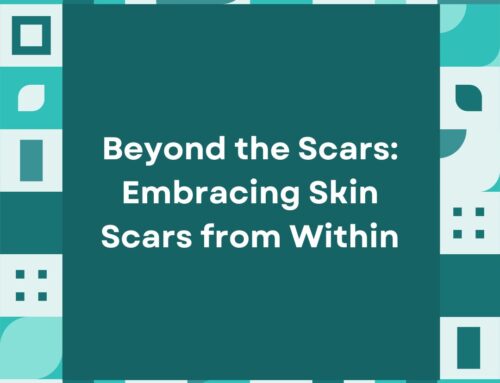Scars can be painful reminders of past experiences, and while they may appear harmless, they can significantly lower individuals’ self-esteem. Makeup techniques for concealing scars have thus become increasingly more widespread. Whether you are looking to conceal acne scars, surgical scars, traumatic scars, or other skin imperfections, scar camouflage is an inexpensive, convenient, and powerful way to improve your appearance and boost your confidence.
In this blog, we will walk you through the countless techniques, color-correcting theories, and other expert tips you will need to achieve blemish-free skin.
Can Makeup Cover Scars?
Yes, makeup is one of the best ways to conceal scars and other imperfections. To get the best results, however, it is important to understand what products are right based on your scarring profile. Read more below to see how to apply make-up for the different types of scars.
How Do I Cover My Scars?
| Scar Type | Makeup Technique | Supplies Needed |
| Flat Scars | Color Correction, Lightweight Foundation | Color Correctors, Lightweight Foundation |
| Concealer, Blending and Buffing | Concealer, Makeup Sponge/Brush, Setting Powder | |
| Setting the Makeup | Translucent Setting Powder | |
| Atrophic Scars | Texturizing Techniques, High-Coverage Foundation | Texture-Filling Primers, High-Coverage Foundation |
| Concealer, Layering Technique | Concealer, Makeup Sponge/Brush, Setting Powder | |
| Blending and Buffing, Setting the Makeup | Translucent Setting Powder | |
| Hyperpigmented Scars | Color Correction, Medium to High Coverage | Color Correctors, Medium to High Coverage Foundation |
| Concealer, Layering Technique | Concealer, Makeup Sponge/Brush, Setting Powder | |
| Blending and Buffing, Setting the Makeup | Translucent Setting Powder |
For flat and discolored scars, color correction is the primary focus. Therefore, it is important to find the right neutralizing colors along with a concealer to further camouflage the scars. Assuming there are no extreme differences in texture, a lightweight foundation would do.
As for atrophic scars, also known as depressed scars, using texture-filling primers will help give the skin a much smoother appearance. To ensure full coverage, a more heavyweight foundation is recommended.
Similar to atrophic scars, hypertrophic scars require texture correction to see a noticeable difference. In this case, we would want to apply a texture-filling product around the raised areas to minimize the disparity in surface level.
Using different products requires a lot of experimentation. Try different brands and formulas and see what works best for your skin.
Color Correcting Techniques for Scars
There is very interesting science to color correction when it comes to makeup. Essentially, by using our knowledge of complementary colors – hues that show up on opposite ends of the color wheel, we can neutralize or cancel out unwanted tones. Generally, these unwanted tones can be categorized as redness, hyperpigmentation (excessive pigmentation), and hypopigmentation (loss of pigmentation).
- Redness: Redness is a very normal sign of healing but can persist and become a nuisance. Using makeup with a green tint, the complementary color to red, can help mute the redness, creating a more even skin tone.
- Hyperpigmentation: Hyperpigmentation, as the term suggests, refers to areas of excessive melanin, leading to a brownish hue. To balance out these darkened areas, warm complementary colors, such as peach or orange, should be applied.
- Hypopigmentation: Hypopigmentation is the opposite of hyperpigmentation. Hypopigmentation manifests as white patches of skin resulting from a lack of melanin. To bring out more warmth in these areas, colors, such as lavender and purple, are recommended. Only a small amount is needed to achieve a noticeable blending effect.
| Discoloration | Color Corrector |
| Redness | Green |
| Hyperpigmentation | Peach/Orange |
| Hypopigmentation | Lavender/Purple |
Color-correcting makeup is only one component to camouflaging your scars. You have to also consider other products, such as foundation and concealer to ensure that your makeup blends in seamlessly. Additionally, it is important to test different intensities and amounts of color-correcting products on your skin to get the best result.
Skin Tattooing – Permanent Scar Makeup
There are a small minority of individuals whose skin discoloration never fully goes away. For those who have undergone all the recommended treatments available to treat hyperpigmentation or hypopigmentation, skin tattooing may be the next best option.
Skin tattooing, also known as medical or cosmetic tattooing, is an effective scar camouflaging technique. With this technique, the tattoo artist essentially matches the color of your scar to that of the surrounding healthy skin.
There are a variety of different techniques that you can explore with a professional tattoo artist, including stippling, feathering, and layering, to achieve a very seamless and natural-looking result.
A lot of patients ask if skin tattooing is appropriate for treating skin redness. Although this could work in theory, skin redness will almost always go away on its own. Additionally, tattooing can even prolong redness because of the hundreds of micro-injuries caused by needle punctures.
#1 Recommended Product for Scar Camouflage – DERMAFLAGE
If you are having trouble looking for the right makeup product to cover your scars, then look no further than Dermaflage. They have a broad selection of makeup products that can cover not only acne scars, but also tattoos, active acne, discoloration, and wrinkles. Additionally, their products were specifically designed by professional makeup artists.
The Scar & Wrinkle Filler is an absolute winner in our eyes. You can choose from a wide selection of skin tones, and the product is easy to apply. They also provide a “texturizing pad” with the makeup kit that you press on the area where makeup was applied to match the natural texture of the skin.
Conclusion
Makeup is an inexpensive and convenient solution to hiding stubborn acne scars. There are two essential factors to consider when trying to optimize scar camouflage: texture and color. For texture, it is important to find a topical “filler” to fill in your indented scars or to minimize the raised appearance of raised scars.
As for color, understanding the neutralizing effect of applying complementary colors to the discolored areas on your skin will further improve the appearance of your scarring. There are a variety of products online that can help you achieve both effects, most popular of which is Dermaflage.
Get in touch with us at Scar Healing Institute for answers to all of your questions. Because we are a scar healing clinic, we will always endorse the most advanced treatments available for your scars. However, makeup is by far one of the best ways to provide immediate, albeit temporary, improvement to your scars, empowering you to look and feel your best.
Schedule an Appointment
Scar Healing Institute
Scar Healing Institute is committed to developing the most effective treatments for scarring. Our team of scar revision specialists are continually inventing the latest technologies and formulas to deliver the best results for our patients.




